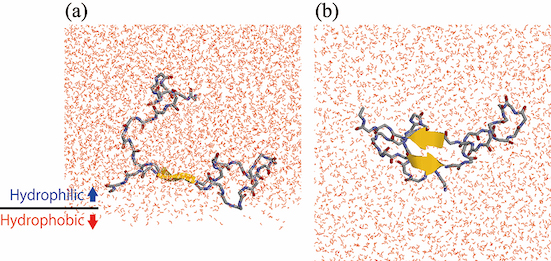Formation mechanism of the causative substances of Alzheimer’s disease revealed by molecular dynamics simulations and NMR experiments.
Alzheimer’s disease is caused by aggregates of amyloid-β (Aβ) peptides. This aggregation is accelerated at a cell membrane surface. The research group at ExCELLS revealed the reason of this phenomenon by molecular dynamics simulations and NMR experiments. The findings were published in the Journal of Physical Chemistry B.
Many proteins aggregate at higher concentrations and form spherical substances called oligomers and acicular substances called amyloid fibrils. These protein aggregates cause more than 30 kinds of diseases, for example, Alzheimer’s disease is thought to be caused by the oligomers and amyloid fibrils formed by aggregation of amyloid-β (Aβ) peptides. It is known that aggregation of Aβ peptide is accelerated at a hydrophilic/hydrophobic interface such as a cell membrane surface. However, why the Aβ peptides tend to aggregate on the surface has not yet been well understood.
The research group at Exploratory Research Center on Life and Living Systems and Institute for Molecular Science, Japan worked on this problem using molecular dynamics simulations and nuclear magnetic resonance spectroscopy experiments. They found that the Aβ peptides tend to gather at the hydrophilic/hydrophobic interface. That is, the local concentration of Aβ at the interface is higher than that in bulk water solution. In addition, β-hairpin structures are formed more at the interface than in the bulk water solution. In the β-hairpin structure, as shown in the figure, a part of the Aβ peptide extends straight and forms intramolecular hydrogen bonds. Therefore, another Aβ peptide that comes close to this peptide is easy to make intermolecular hydrogen bonds and tends to aggregate. In this way, the research group clarified that the reason for accelerating the aggregation of the Aβ peptides on the cell membrane surface is that not only the Aβ peptide tends to have high concentration on the cell membrane surface but also it takes a structure that tends to bind to each other.
This discovery enables us to elucidate the mechanism by which the Aβ peptide aggregates on the membrane surface of nerve cells. Elucidating this mechanism will be applied to developing inhibitors against the causative substances of Alzheimer’s disease in the future.
Figure

(a) An Aβ peptide that forms a β-hairpin structure at the hydrophilic/hydrophobic interface. (b) View from the bottom of panel (a).
Information of the paper
Authors:
Satoru G. Itoh, Maho Yagi-Utsumi, Koichi Kato, and Hisashi Okumura
Journal:
Journal of Physical Chemistry B
Title:
Effects of a Hydrophilic/Hydrophobic Interface on Amyloid-β Peptides Studied by Molecular Dynamics Simulations and NMR Experiments
DOI: 10.1021/acs.jpcb.8b11609
Research Group
Satoru G. Itoh and Hisashi Okumura
Okumura Group, Institute for Molecular Science (IMS), Exploratory Research Center on Life and Living Systems, National Institutes of Natural Sciences, Okazaki.
Maho Yagi-Utsumi and Koichi Kato
Kato Group, Institute for Molecular Science (IMS), Exploratory Research Center on Life and Living Systems, National Institutes of Natural Sciences, Okazaki.
Financial Supports
MEXT/JSPS KAKENHI JP24740296 (Satoru G. Itoh)
MEXT/JSPS KAKENHI JP17K15441 (Maho Yagi-Utsumi)
MEXT/JSPS KAKENHI JP25102001, JP25102008 (Koichi Kato)
MEXT/JSPS KAKENHI JP26102550 (Hisashi Okumura)
Okazaki Orion Project (Koichi Kato and Hisashi Okumura)
Contact
Hisashi OKUMURA
Exploratory Research Center on Life and Living Systems
National Institutes of Natural Sciences, Okazaki.
TEL:0564-55-7277 FAX:0564-55-7025
E-mail:hokumura_at_ims.ac.jp
Press contact
Exploratory Research Center on Life and Living Systems, Natural Institutes of Natural Sciences
TEL: +81-564-59-5504
FAX: +81-564-59-5226
E-mail: press_at_excells.orion.ac.jp
Public Relations, Research Enhancement Strategy Office, Institute for Molecular Science, Natural Institutes of Natural Sciences
TEL: +81-564-55-7209
FAX: +81-564-55-7374
E-mail: press_at_ims.ac.jp
Please replace the “_at_” with @

